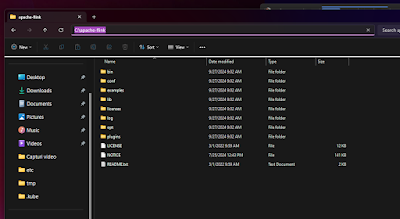Requirements to Install Apache Flink on Windows
Installing and running Apache Flink on a local Windows machine requires the following things.
Windows 10
We need Windows 10 with the Windows Subsystem for Linux (WSL). But if your version of Flink binary has .bat files, then you don’t need these and can use another Windows version and run with cmd. But the version I am using only has the .sh files.
Java
The second requirement is Java. Java version 8 or 11 is recommended. It doesn’t matter if you use OpenJDK or Oracle-provided Java on the machine.
Verify your java with java -version. Also, make sure you set up your Environment Variable JAVA_HOME otherwise, the Flink won’t create any Job.
Download Latest Apache Flink on Local Windows
Now that the requirement is fulfilled, let’s jump to the next part.
As I said earlier I will be installing Apache Flink version 1.20.0 for this post.
To get the list of all Flink binaries available to download, head over to this link: Downloads | Apache Flink.
Select the version you want to choose and download. You may be redirected to another page and in the 1st paragraph, you can see the mirror download link.
I will be selecting Flink Version 1.20. 0for download. and then select the -bin-scala_ file.
Start and Stop Apache Flink Cluster on Local Windows
Now that we have downloaded the Apache Flink binaries, let’s extract the tar file and copy it to a more appropriate location, any location would be fine, I will be putting it on c:\apache-flink\flink-1.20.0.
But in WSL the path will be, /mnt/c/apache-flink/flink-1.20.0.
In the terminal, WSL, run the cluster with the following command.
If it is successful then you will see a cluster start to message and the cluster will run in the background.
Then simply go to the localhost:8081 to access the Flink UI Dashboard.
To stop the cluster use the following command.
./bin/stop-cluster.sh
Run a Flink Job on Cluster
There are 2 ways you can run a Flink Job on the cluster. UI and via command.
Run Flink Job via Flink Dashboard
The simplest way is to use the UI. First, in the dashboard, go to the Submit New Job page and upload the Jar. Next, select the Jar from the list, and pass the Main class, the argument of the program. Then, submit the job and it will redirect you to the running job page, where you will see the pipelines and their status.
Run a Flink Job via Terminal
The second way is to run it via the Terminal or Command-Line. You can use the following command to run the Flink Job.
./bin/flink run --detached /path/to/jar/SampleFlinkJob.jar
This will run the Flink job in the background. You can then check the status in the Flink Dashboard, on localhost, if it runs successfully.










